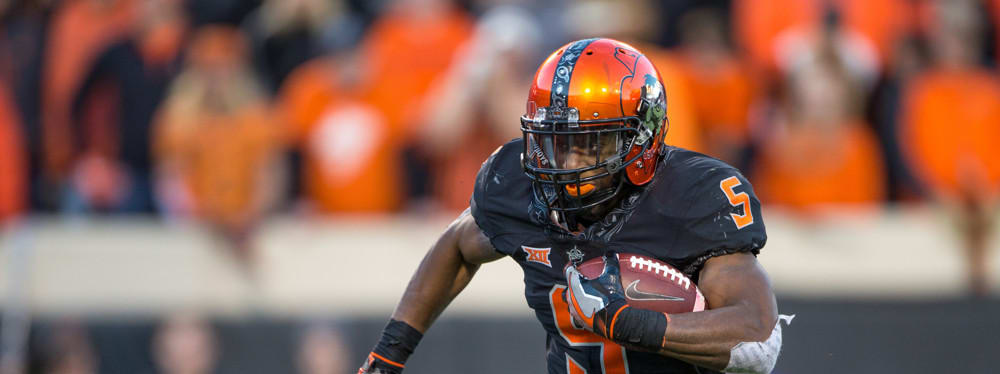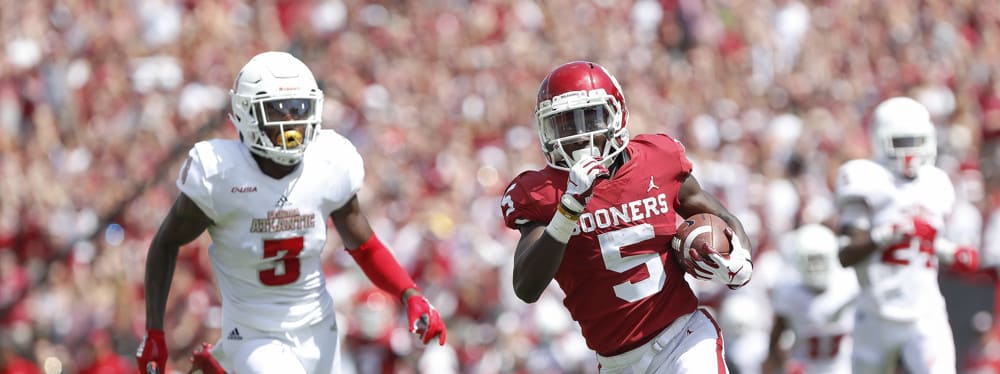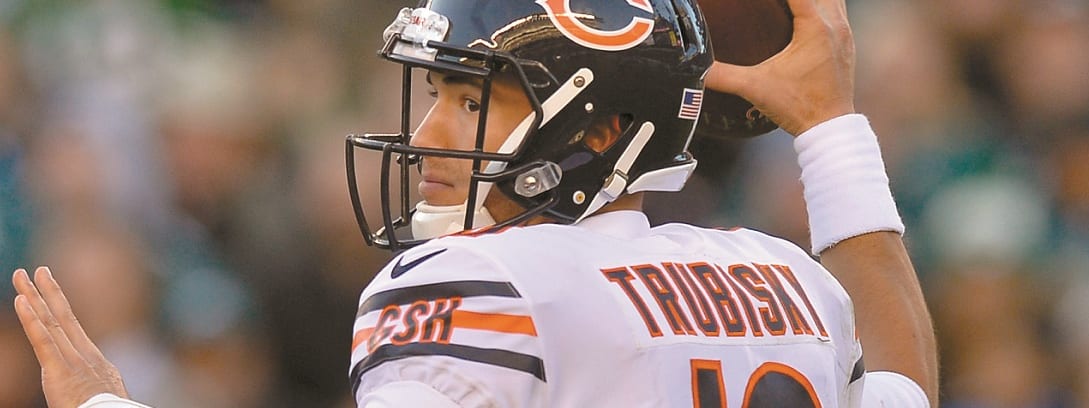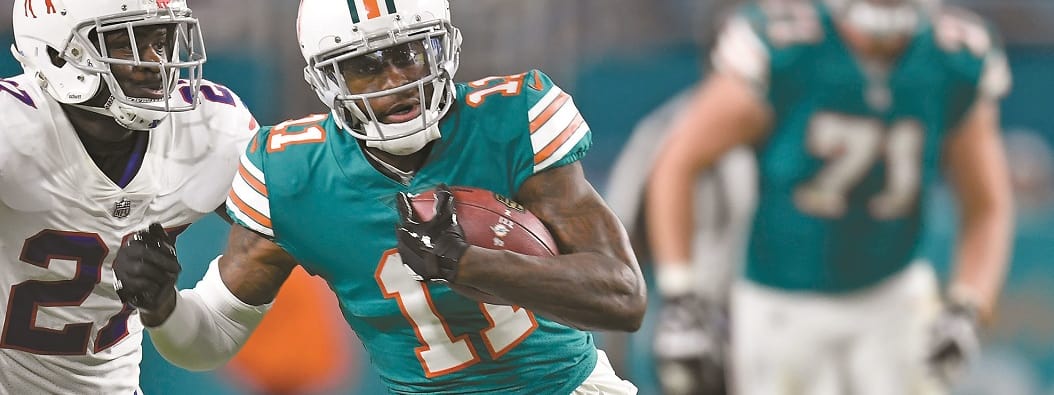During his 14th NFL season in 2016, Boldin led Detroit with eight touchdown receptions. It's true he also logged a career-low 584 receiving yards, but that doesn't necessarily mean he's lost a step. In fact, the Florida State product looked like the Boldin of old, using his veteran savvy to get open in traffic and his vice grip-like hands to haul in short strikes from Lions QB Matthew Stafford. Boldin was one of the best free-agent pickups in the league last year and the Bills were hoping to see that transpire again in 2017. Alas, the veteran wideout announced his retirement in August after a brief stint with Buffalo.
Boldin has defied the aging process for so long, and he'll attempt to keep the streak alive with the Lions. At age 35, he managed a pedestrian 11.4 YPC and 7.1 YPT last year, but given the 49ers' passing offense ranked 25th in YPA (6.9), he wasn't that bad. At 6-1, 220 pounds, with great hands, once-in-a-generation toughness and rare football intelligence, Boldin has put together a Hall of Fame-level career, despite being one of the slowest receivers in the league - he ran a 4.72 40-yard dash at the NFL Combine in 2003. Perhaps that's why he's aged so well - he never had any steps to lose. Boldin has only modest upside at this stage of his career, but the aforementioned attitude will likely mesh well with quarterback Matthew Stafford.
Few receivers in NFL history have aged as well as Boldin. Despite turning 34 in October, Boldin managed a 1,000-yard season and passable 8.1 YPT on a team that finished 23rd in the league with 7.0 YPA and 31st in passing yards (3,407). And this follows an even better 2013 in which he averaged 9.1 YPT and amassed 1,179 yards. Whether Boldin can reprise his role as the team's top receiver in 2015 is less clear. It's not only that he'll turn 35 midway through the year, but also the team is in transition with a new coach and coordinator, a new co-No. 1 wideout in Torrey Smith, new weapons out of the backfield and a defense that's likely to be significantly worse. If quarterback Colin Kaepernick is forced to throw more, that should benefit all of his top targets, and Boldin projects as one of them with only Smith, tight end Vernon Davis and backup tailback Reggie Bush having any track record of NFL success among the team's pass catchers. At 6-1, 220, Boldin is a rock, as tough a receiver as has ever played in the league, and his hands, route running and competitiveness are top shelf. One thing he is not, however, is fleet of foot — he ran a sluggish 4.72 40 at the NFL Combine in 2003, and players do not typically get faster into their mid-30s. But he can make plays without much separation and can still be an effective possession receiver.
Slow, old and having signed with a new, run-first team, Boldin nonetheless had another strong year in 2013. He averaged 9.1 YPT (10th), had 17 catches of 20-plus yards (T. 12th with A.J. Green) and came up big in the playoffs with two touchdowns including a huge catch against the Seahawks. At 6-1, 220, Boldin is a tough physical receiver with good athleticism, excellent hands and off-the-charts competitiveness. While he’s slower than many tight ends, he doesn’t need a whole lot of separation to make plays. This year he should see a significant reduction in targets, however, with Michael Crabtree healthy again and Steve Johnson now in the fold. And of course tight end Vernon Davis will have a significant role as well.
One of the Ravens' playoff heroes last season, Boldin was shipped to San Francisco for a sixth-round pick in March.
Even before the playoffs Boldin had a solid season in 2012, averaging 14.2 YPC an 8.2 YPT. He scored only four times, thanks to seeing only nine red-zone targets all year, and given Boldin's lack of downfield speed, he's unlikely to strike from deep.
At 6-1, 223, Boldin is a stout, physical receiver, with good athleticism, excellent hands and off-the-charts competitiveness and toughness. He should see more work this year with Michael Crabtree likely to miss most of the season with a torn Achilles' tendon, but it's unclear whether Boldin's still capable of being a top target at age 32 and likely Vernon Davis, Mario Manningham and last year’s first-rounder, A.J. Jenkins, also see bigger roles.
After escaping Larry Fitzgerald’s shadow in Arizona, Boldin’s been something of a disappointment as the lead dog in Baltimore. Despite playing 14 games and seeing 15 red-zone looks, he scored just three touchdowns and managed just one play of 40-or-more yards. He did have 15 catches of 20-plus on 106 targets and was fairly efficient with 8.4 YPT and 15.6 YPC. At 6-1, 218, Boldin’s a tough physical receiver, unafraid to make plays in traffic and able to snatch the ball out of the air with defenders around him. He’s athletic and highly competitive, but lacks the speed to beat defenders down the field. He seems more or less the same player he was in Arizona, but without the high target volume as the Ravens are a run-first team with a strong defense that likes to spread the ball around. He’ll be 32 in October, but has played 30 games over the last two seasons and could have another decent season or two left before he really slows down.
After a quick start to the season, Boldin seemed to vanish into thin air, recording only one game of more than 65 yards after Week 7. Moreover, after seeing 10 or more targets in four of his first seven games, he never reached double digits again. All while remaining healthy for the first time since 2006. Boldin's per play numbers (13.1 YPC, 7.7 YPT) were roughly in line with what he did in 2009, though a bit down from his peak. At 6-1, 218, he's a tough, physical receiver in the mold of Hines Ward, but with more athleticism. He's never been a big downfield threat and didn't get a lot of looks in the red zone (12), either. In sum, Boldin's healthy heading into 2011 and at age 30 should still have something left in the tank.
Going from Arizona to Baltimore seems like a
downgrade for a receiver, but in this case, it’s
probably not. Not only does Boldin escape Larry
Fitzgerald’s shadow to become the unquestioned
top target, but he also gets out before the
post-Kurt Warner era begins.
Boldin is the NFL’s all-time career leader in
yards per so the key for him is simply remaining
on the field. While Boldin played 15 games last
year, he missed both of the team’s playoff
games with knee and ankle injuries, and he
played in only 12 games both in 2007 and
2008Boldin is an ideal red-zone
target. He runs excellent routes and is unafraid
of contact over the middle of the field
Boldin’s should be completely healthy and he should have no trouble establishing
himself as the best outside weapon third-year
quarterback Joe Flacco has ever had.
Because Larry Fitzgerald was so dominant in the Cardinals’ playoff run, it’s easy to forget Boldin was actually the more productive fantasy wideout for most of the regular season.
While Fitzgerald finished with 12 touchdowns in 16 games, Boldin had 11 touchdowns in just 12. And it was Boldin who led the league in red-zone touchdowns, converting a whopping 10 of his 23 targets into scores. (Fitzgerald was nine for 30). Boldin also tied Fitzgerald (and Dwayne Bowe) for the league lead in goal-line targets with 10. While Fitzgerald hauled in an impressive 62 percent of the total targets thrown his way, Boldin was like a vacuum cleaner, sucking in 71 percent (2nd).
Of course, part of the reason Boldin was so good at securing completions was that the ball didn’t have to travel very far to reach him – his 11.7-yard average ranked 30th among the league’s 100-target wideouts. As a result he averaged just 8.2 yards per target, respectable, but nothing special, particularly when you consider that he hauled in such a high percentage. He also had just 10 receptions of 20 yards or more (tied for 33rd) and three from 40-plus. In other words, over the last two seasons, Boldin has evolved into a first-rate possession receiver and red-zone threat, while the team looked to Fitzgerald when it needed a big play.
At 6-1, 217, Boldin has excellent size, but he’s also physical, tough and unafraid of contact in the middle of the field. He’s not particularly fast, but he’s a good athlete who runs first-rate routes and has soft hands. The biggest knock on Boldin is his tendency to get hurt – he played 16 games just once in the last five seasons and missed four games in each of the last two with hip, toe and shoulder injuries as well as a nasty facial fracture. He was also hobbled in the playoffs with a hamstring injury that caused him to miss the team’s game against Carolina entirely.
At press time, Boldin was sitting out mandatory minicamp practices due to a hamstring injury, though there was some question as to whether Boldin wasn’t exaggerating the condition as part of a ploy to have his contract redone. Boldin’s made it no secret he’s unhappy about being underpaid, and while the Cardinals have entertained trade offers for him, their asking price was exorbitant, and it’s likely a disgruntled Boldin will remain in Arizona again this season. While that might be cause for concern with many receivers, Boldin’s unhappiness with his contract has never affected his play on the field.
Hip and toe injuries cost Boldin four games
in 2007, and he’s already missed 12 in his career.
When he was healthy, Boldin was less explosive
than usual (possibly due to the bruised hip that
lingered most of the season), averaging just 12
yards per catch. But Boldin caught a whopping
72 percent of the passes thrown his way (good
for second in the league among receivers with 70
targets or more).
Boldin also saw 15 red-zone looks, just two
fewer than his teammate Larry Fitzgerald who
played 15 games. But Boldin was the team's leading target inside the five, getting eight, four of which he brought in for scores. Prorated for a full 16-game season, Boldin would have tied Marques Colston for the league lead in goal-line targets, so it seems that at least for one year, freshman head coach Ken Whisenhunt called Boldin's number near the endzone.
At 6-1, 220, Boldin’s got excellent size (though
he’s not quite as big as Fitzgerald), tremendous
strength and very good hands. He’s not fast, but
he’s got good quickness for a big receiver, runs
tight routes and is hard to bring down after the
catch. He’s also tough enough to go over the
middle and does not shy away from contact.
There were rumors this winter Boldin was
seeking a trade, and he skipped a voluntary
workout in May, but at press time, it looks likely
that he’ll remain in Arizona. As long as Fitzgerald is also healthy, the targets will be divided fairly evenly between the two.
After leading the NFL in targets in 2005, Boldin was again near the top of the league in 2006 with 153 (fifth), but for the second year in a row, only 11 of those looks were in the red zone. While Boldin was able to score from further out two years ago, he managed just four touchdowns total in 2006, two from inside the 20. Part of the problem was that Boldin fell out of favor in coach Dennis Green’s attack later in the year, and teammate Larry Fitzgerald, despite missing three games with a hamstring injury, saw seven more balls thrown his way (18) from inside the 20.
But with Green out of the picture, and former Steelers’ offensive coordinator Ken Whisenhunt taking over, Boldin should once again resume the role of Arizona’s primary playmaker. Boldin’s skill set is similar to Hines Ward’s, and Ward thrived in Whisenhunt’s system. Boldin, who played some quarterback at Florida State, might even be asked to throw some passes on gadget plays.
At 6-1, 220, Boldin can overpower smaller defensive backs and has no problem mixing it up in the middle of the field He’s a very good route runner with good body control, and plenty of quickness for his size. He’s difficult to bring down in the open field, and he’s a good after-the-catch runner despite lacking breakaway speed.
The arrival of Whisenhunt does have a downside, however, and that’s his proclivity for the power running game that made the 2004-05 Steelers into one of the most run-heavy teams in the modern era. Of course, Pittsburgh’s defense was far better than Arizona’s, and the Cardinals personnel is more pass-oriented, but there are likely to be less targets to go around in 2007.
It’s hard to comprehend how a player with a 165-target teammate in Larry Fitzgerald could lead the NFL in targets while missing two full games, but Boldin did just that. The Cardinals' running game was so terrible that their quarterbacks threw virtually every play, and while that wasn’t good for Kurt Warner’s health, Arizona’s two big receivers were among the league leaders in most of the major receiving categories. But that’s nothing new for Boldin, who caught 101 passes during his rookie year and 56 in nine games in 2004. From the day he set foot in the league, Boldin has been among the top few receivers in per game production. At 6-1, 220, Boldin can outmuscle defenders and make tough catches in traffic over the middle. He’s a sharp route runner with good body control, and plenty of quickness for his size. He’s hard to bring down, and he’s a good after-the-catch runner despite lacking breakaway speed. In fact, Boldin had five catches for more than 40 yards in just 14 games, and six for more than 40 during his rookie season. While Boldin and Fitzgerald were essentially targeted equally in the red zone, Boldin’s attempts came from farther out. As a result, Boldin’s 11 catches inside the 20 went for 133 yards and on four touchdowns, while Fitzgerald’s 11, went for just 62 and but six scores. While the arrival of Edgerrin James should in theory reduce Arizona’s reliance on the passing game, it’s an open question whether the high-mileage back will be able to succeed behind what was a very weak run-blocking line in 2005. (The Cardinals did draft guard Taitusi Lutui in the second round and hired former Vikings offensive line coach Steve Loney this offseason). If James is effective, the Cardinals won’t be throwing quite as much, especially if their defense continues to improve. If James struggles, or the defense takes a step back, Boldin’s looks will increase early on, but that means Warner would be taking a pounding, and the team would probably be doing poorly. In that case, we could see Matt Leinart under center before the season is out, a development that would almost certainly hurt both star wideouts in the short term.
Boldin missed most of training camp and the first six weeks of the regular season after undergoing surgery to repair torn cartilage in his right knee last August. When he returned, it took him a couple games to get up to speed, and by that time coach Dennis Green was in experimental mode at quarterback, benching starter Josh McCown for such luminaries as John Navarre and journeyman Shaun King. Still, Boldin managed a couple 100-yard games and showed he was 100 percent healthy. Boldin (6-1, 218 pounds) is a big, powerful receiver who will go over the middle, catch balls in traffic and break tackles. Boldin has excellent agility and good hands, but lacks blazing speed. With Kurt Warner in the fold, and teammate Larry Fitzgerald now with a season under his belt, the Cardinals passing game has a chance to take a major step in 2005, and Boldin should pick up where he left off during his rookie season. Boldin, who missed the team’s mandatory minicamp in April as he seeks to renegotiate his contract, showed up for workouts with the team in May and has vowed not to hold out even if the two sides don’t reach an agreement before the season.
Often compared to Ward for his less-than-stellar speed, good hands and willingness to go over the middle, the NFL Rookie of the Year led all receivers in yards after catch (571), was fourth in plus-25-yard catches (12) and third in times targeted (165/61 percent complete). There will be less opportunity for Boldin in ’04, as Dennis Green’s former ball boy, Larry Fitzgerald, will be a co-star in the Cardinals’ passing game. Fitzgerald’s presence will likely hurt Boldin most in the red zone (where he caught 10 passes for five TDs last year). Expect Green to feature the bigger and more acrobatic Fitzgerald more prominently inside the 20. Boldin was a slow starter last year, catching just one TD pass in the first half of all games, but the first quarter of this season will be lost due to injury. And he’ll have to adjust to playing split end rather than the more familiar flanker spot he enjoyed last season, though Green expects this to make him more difficult to double-team. Boldin could slide deep because of this as owners are wary of Fitzgerald, but remember that Dennis Green’s Minnesota teams generally got premium fantasy production out of both starting wide receivers. He should still make solid contributions in the second half, so keep him in mind for the later rounds.
A slow time at the combine, and a knee injury, knocked Boldin out of the first round, but he still might wind up starting for the Cardinals.











